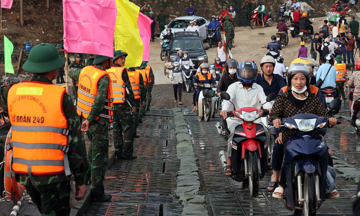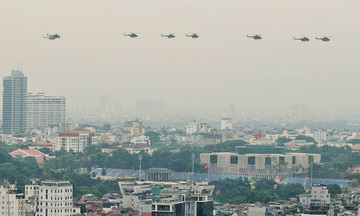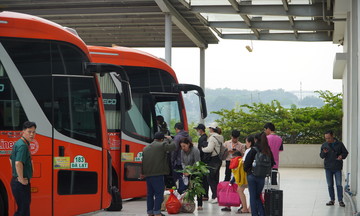At a meeting with around 30 transport company representatives in Hanoi on 1/8, Major General Do Thanh Binh, Director of the Traffic Police Department (under the Ministry of Public Security), cited statistics showing trucks and buses make up 2.49% of registered road vehicles but are involved in 37.1% of accidents and 40.27% of road deaths. One in every three accidents involves a truck, trailer, semi-trailer, or bus.
In the first 7 months of 2025, 4,000 accidents involving trucks and buses occurred nationwide, resulting in 2,466 deaths and 2,106 injuries. The most recent incident was a sleeper bus rollover in Ha Tinh, which killed 10 people.
Major General Binh expressed his concern, stating, "What's the point of earning millions, even billions, if your vehicle is involved in an accident that takes lives?" He questioned the attendees, "Can you sleep soundly knowing these figures?"
 |
Major General Do Thanh Binh speaks at the meeting on 1/8. Photo: Viet An |
Major General Do Thanh Binh speaks at the meeting on 1/8. Photo: Viet An
Nguyen Cong Hung, Deputy General Director for Northern Vietnam at Mai Linh Group, explained the situation, pointing out that many accidents are addressed after the fact rather than prevented. He stated that there's a fundamental flaw in the system. The transport business is a conditional sector, yet "anyone can operate in it." He questioned, "Transport companies are required to have safety monitoring departments, but who oversees individuals with two or three vehicles?"
Phan Thanh Uy, Vice President of the Vietnam Automobile Transportation Association, agreed, expressing disapproval of the current transport business model and advocating for stricter regulations. "Only large transport companies invest in safety. Individuals with one or two vehicles, where the husband drives and the wife assists, can't afford digital transformation or safety equipment," he said.
Vu Duc Hoang, representing Hoang Long transport company, argued that sleeper buses are unsafe because they are converted from 45-seat vehicles. To save money, most owners neglect to install electromagnetic brakes (a secondary braking system), even removing them entirely due to the high cost of hundreds of millions of dong. He recommended this system for vehicles traveling over 200 km, especially in mountainous areas.
Hoang also mentioned lax driver testing, particularly for those with D and E licenses. "We've found drivers with fake licenses. Due to this laxity, some drivers have almost no understanding of the law. We shouldn't blame the drivers but examine our own role in this," he said, proposing a ban on bus operation from 2:30 am to 5:30 am, a period when drivers are prone to drowsiness due to disrupted sleep patterns.
 |
A representative from Hoang Long transport company speaks at the meeting on 1/8. Photo: Viet An |
A representative from Hoang Long transport company speaks at the meeting on 1/8. Photo: Viet An
Major General Binh shared that in 2014, he contacted a major South Korean vehicle manufacturer. The company responded that it had never produced sleeper buses because the vehicle's center of gravity is high, requiring significant electrical system modifications. These conversions are primarily done by secondary manufacturers.
Regarding the proposed ban on overnight bus operation, Major General Binh acknowledged its consideration but noted other factors requiring resolution.
At the meeting, Nguyen Cong Hung suggested reconsidering the necessity of vehicle decals. Commercial transport vehicles already have yellow license plates and inspection stickers. "Decals currently only distinguish transport types like fixed-route, contract, or taxi," he said, noting that many vehicles operate without decals, unmanaged.
If decals are retained, Hung proposed that traffic police impound vehicles without them and impose severe penalties, even prosecution, for counterfeit decals.
The Vietnam Automobile Transportation Association representative concurred, stating that vehicle decals are obsolete. "When all plates were white, decals were needed for differentiation. Now with yellow plates, they are unnecessary and should be eliminated urgently," the representative said.
 |
Nguyen Cong Hung suggests reconsidering vehicle decals. Photo: Viet An |
Nguyen Cong Hung suggests reconsidering vehicle decals. Photo: Viet An
Companies also raised concerns about delayed processing of automated fines. A GSM taxi company representative reported having nearly 40,000 vehicles nationwide, with almost 9,000 in Hanoi. Around 200 vehicles in Hanoi have pending automated fines, with potentially thousands across the country, creating processing difficulties. Many drivers quit upon receiving fines, and vehicle inspections require driver's licenses. Unable to contact drivers, hundreds, even thousands, of vehicles are out of service due to failed inspections.
A Mai Linh representative shared similar struggles with fines from two years prior. "Paying the fines is a hardship, sometimes requiring trips to drivers' hometowns for verification," he said.
Major General Binh assured businesses that traffic violation notifications will be issued within two hours, eliminating the need to wait for inspections. The department has also proposed simplifying the fine processing procedure to the Ministry of Justice, addressing the current complex process and excessive paperwork.
Viet An












